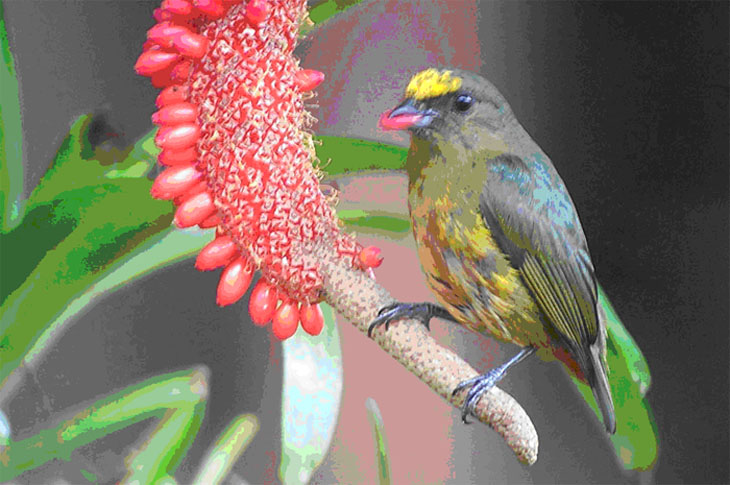|
|---|
Tropical Birds Found in the Jungle- Olive Backed Euphonia |
Broken News
Starbuck's Progress
In May of this year the Chronicles reported the opening of Starbuck's first store in Costa Rica (Starbuck's Entrada). It's situated between Hospital CIMA and the Marriott Inn deep in the heart of the American ghetto of Escazú, a western suburb of San José. Reports are that the store is doing well.
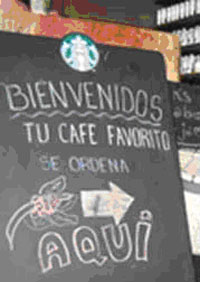 |
|---|
The Sign Says It's Already You're Favorite Coffee |
Of course, excellent coffee has been produced and enjoyed in Costa Rica even without Starbuck's for over two hundred years (see Choo Choo Chiquita, Coffee, Bananas, Microchips Anyone? and Java and More Java) but there has been very little variation in what Tico coffee purveyors offer at local establishments. You can have it black or black with cream or black with sugar or go the whole nine yards and have it with cream and sugar.
Starbuck's is using locally grown and roasted coffees (a good portion of the company's worldwide need is grown here) So what do they bring to the market? The name for their marketing edge is what they call "personalized service". This consists of making up virtually any concoction you can dream up, and they have the syrups, powders and other stuff to make it happen. A lot of these concoctions are rather sweet.
Will Ticos take to all this fiddling with their basic product?
My guess is they will for two reasons. First, Starbuck's is more than a street vendor of coffee. It's more like a social experience as people gather at their stores to hold impromptu conversations, meetings, work on a computer or read a book. Starbuck's is kind of the modern version of an old tradition - people gathering around the cracker barrel at the general store. And Ticos are very social (see Soy Tico) yet there are not many places in Ticoland where space is set aside for kibitzing, other than park benches and the walking streets in San José.
Secondly, Ticos love sweet things and have a predisposed pallet for fruity flavored drinks ("naturales" and "batidos" or fruit shakes for example). My expectations for success will be confirmed when Starbuck's opens its second store here. Would that it were in Quepos amigos, but I hope unrealistically, at least for this decade.
Starbuck's now has almost 20,000 stores in 61 countries worldwide including the latest asian opening in Mumbai, India.
Yeah, but waddayado for an encore after you've got Escazú and Mumbai covered?
¡Pura Vida, Amigos!
Driver's License Changes
Prior to moving here in 2008, GG had visited Costa Rica eight times and rented a car on the last six of those trips. There was never a question about getting a car based on a U.S. driver's license. As far as I know anyone can still rent a car that way, but the stay here, including the vehicle, is limited to 90 days on the tourist visa. Going beyond that point makes the vehicle and driver illegal.
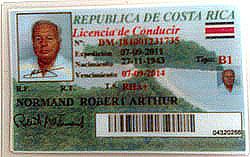 |
|---|
GG's Costa Rica Driver's License |
During the process of obtaining a cédula (residency document) GG thought he might as well go ahead and get a driver's license. I'm not sure why I thought that way at the time, considering I don't own a car anymore, but maybe I thought it would be nice to have a second locally based picture ID besides my cédula.
On one of my trips to San José for cédula purposes I trudged to the MOPT office (Ministerio de Obras Publico and Transportes - similar to the Florida DMV) in La Uruca and, after getting a blood test, I obtained a license on the basis of my Florida driver's license and my U.S. passport number. Until now, it has been quite easy for any foreigner to obtain a C.R. license based on those two valid documents.
No mas amigos. Now, because of recent changes in the law, you now must have a cédula to get a Costa Rica driver's license. This should not be a problem for visiting tourists as they can still drive a car, rental or otherwise, on a valid foreign license for up to 90 days. But if you move here you also have only 90 days to drive around in a vehicle you either you had shipped here or bought here. After that, the vehicle becomes illegal and the foreigner's drivers license invalid until the visa is renewed.
And taking the vehicle across the border to get a 90-day renewal can be iffy and may require staying out of the country 30-60 days (that's what happened to a friend of mine). The cédula process can take 6-12 months to complete so a temporary visa on a vehicle can run out long before the cédula is received.
The point is, if you're contemplating moving here and intend to drive your own car, you should start your cédula process as early as possible. Remember, you don't have to actually establish physical residency here to start the process of obtaining a cédula. You can get a cédula by initiating the process at any time, even getting the card while actually living in another country (a friend of mine did just that).
Tico Rithmetic
As an old business dude with experience in capital planning and investment analysis, I’ve had to deal with depreciation routinely in the past.
Depreciating an asset over its “useful life” is a time-honored way of leveling out both taxes due on profits and smoothing out business performance due to a one time large investment. And I’ve heard of accelerated depreciation but never decelerated depreciation, which is what the elaborate formula the Costa Rican tax authority put forward results in. The formula was reported in the November 19 AM Costa Rica newsletter.
The formula is simple: If an asset has a useful life of ten years, the straight line depreciation is 10% per year. As a common investment incentive for many capital purchases, the rules may allow double declining balance depreciation in which the first year allowance becomes 20% rather than 10% in the example cited. The formula for depreciation is simply the rate times the current book value (original value less accumulated depreciation), so as the years pass by, the amount of depreciation declines accordingly. Depreciation = Book Value x Rate.
On the other had, The Costa Rican formula for an annual depreciation rate is:
 |
|---|

No Leonard, that’s not a trigonometric formula for the curve of a projectile as it approaches a gravitational body nor anything to do with particle wave theory in a black hole. It’s just the Costa Rican formula for determining the annual depreciation rate of an asset where X is the actual year of the life of the asset and N is the number of years of useful life.
Now there are the same number of variables in the both the DDB and C.R. formulas but the way the C.R. one is employed is cute. Anyone accustomed to using formulas can look at the one above and immediately see that it produces smaller numbers in earlier years and larger numbers in later years. In fact, that's what happened when I ran the numbers based on a 10 year useful life. The first year under the Costa Rican formula produced a 5% depreciation rate versus 20% in the double declining balance method and only about 30% total in the first three years versus almost 50% by way of the DDB method. This essentially raises taxes to an investor in the early years (when they could use the relief) making up for it in later years (when they shouldn't need it as much).
This is one of the investment-discouraging factors previously reported in the Chronicles (Ease of Doing Business Index). A lower rank number means a more favorable business climate; Singapore is #1 and the U.S. is #5 for comparison purposes. Costa Rica ranks 110 overall (lower half of all countries) and 125 on tax complexity and burden (lower third of all countries).
Come on amigos, we can do better than that.
Rumble Talk
(Unstable Happenings on or About the Pacific Rim)
Rapid Rumbles
The area where the "Big One" hit in September of 2012 on the Nicoya peninsula continues to receive regular jolts although most of them are much smaller these days.
.jpg) |
|---|
Red Circle is Nosara |
Nosara on the west coast of the peninsula was close to the epicenter of the September 5 quake. But on November 22 the town experienced five separate earthquakes in 20 minutes.
The tremors occurred in the morning a little after 7 AM and ranged from 3.3 to 4.1 on the Richter scale. That's much weaker than the one that severely damaged the hospital in Puntarenas on 5 September but strong enough to rattle your bones and shake your tukas.
The LIS at UCR (Laboratorio de Ingeniería Sísmica at the Universidad de Costa Rica) said this activity was once more a fall out from the 7.6 window breaker of September 5. The five quakes in the morning of November 22 were distributed like a cluster bomb around Nosara (see map), a town not far north of the September epicenter..
All I could think of when I heard about the series of five quakes was that I'm usually in the bathroom about that time of the morning making my "toilette" as the French would say. It must be really unnerving trying to shave safely when the floor is moving independently of the rest of you.
Are We Having Fun Yet?
The LIS laboratory at the University of Costa Rica mentioned above monitors quakes and keeps historical information about them. They recently published the chart below that shows the number of quakes experienced in Central America over the years 1970 to 2012.
 |
|---|
Major Earthquakes in Central America by Year 1970-2012 |
This chart plots only the quakes greater than 4.5 Richter. and shows the mean or average number for the latest 25 year period (red line is average - about 110 per year). And there are literally thousands of quakes of lesser than 4.5 R
The chart shows that we were above average by about 20 quakes for a total of about 140 in 2012 but that there were several years during the 42 year period when the number of quakes significantly exceeded this year's total.
There were almost 250 quakes in 1993, the year that holds the record for this period. That's almost one per day. The second highest peak was about ten years later when the number over 4.5 reached about 180.
The year 2005 looks like a low point on the chart but I believe that also was the year I came here for a visit and, while motoring down the coastal highway south of Parrita getting excited about getting close to my destination, I rounded a curve only to find a very large saw horse in the middle of the road. I had to deviate around it. The road had cracked and separated by about 18". I believe that year also was when the Salsipuiedes restaurant in Manuel Antonio was cracked nearly in half and it took a few months for them to restore business.
As stated before, it doesn't have to be a 7.6 to kill you or do serious damage.
And Even More
On Thursday, December 13, 11:20 AM, while writing this newsletter, my computer started to dance and the whole apartment came alive again. In two distinct shocks about one minute apart, the Cocos and Caribbean plates made their presence known once more. The radio people here must be tied closely to the Seismological center at the University of Costa Rica because there were radio reports as to the epicenter and strength within minutes of the event. This one was centered near Uvita, about 35 miles south of Quepos and reached 5.2 on the Richter scale. No major damage or injury reported, just the uneasiness that comes with not knowing how bad it's going to be.
Hablo Español Muy Good
(More on Misusing/Abusing My Adopted Second Language)
After four years here, over two of those taking Spanish lessons, my guess is GG has achieved a proficiency of perhaps a second or third grade level. Now that's a considerable improvement over the pre-kindergarten (make that toddler) capability I had when I arrived, but it's still a struggle. I will know when I've reached high school proficiency when the person I'm trying to engage in conversation doesn't automatically switch to English after my first sentence.
 |
|---|
"The Only Spanish Words Grandpa Knows are Cigar Names?" |
There are permanent residents who come here to Custa Reeka, migrating to Qwaypost (Quepos) or Jack-oh (Jacó), who don't bother to learn the language or simply refuse to. They never get beyond the basics that most tourists master, i.e., 'Buenos Dias - good morning' or 'donde esta el baño - where is the bathroom?' or 'cuenta costa - how much does this cost?' I know a couple of people in this category who still don't know that there is a difference between buenos dias and buenas tardes or buenas noches.
What it takes to get more proficiency, particularly for an old geezer like GG, is a good deal of willingness to learn, determination and, above all practice. I try to practice with Ticos at every chance possible. That's not always easy as many Ticos speak better English than I speak Spanish (or just want to practice) and they quickly break into English. Sometimes GG gets frustrated at his progress but I'm too damn stubborn to give up. Yet, at the least, I have gotten over being self-conscience about making errors and the self-imposed embarrassment that might come with them. I just load the torpedoes and forge on. Pura vida!
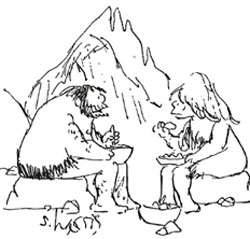 |
|---|
| "I miss the good old days when all we had to worry about was nouns and verbs" |
| Spanish Caveman Nostalgia |
One of the things that gives me encouragement that I am making progress is listening to tourists and visitors murder the language. Some people think if they just speak English loud enough, they will be understood (in Costa Rica, loud speech just attracts the policia amigos). Others think if they pronounce the English word with a Spanish intonation they might be communicating, four eggzampil: "Yo, ees necceesario for me finedeen gasoleena for car-oh" or "Joo haf a boootifool coontree heah". This behavior simply adds to the antics of the monkey population here.
Getting use to the number system is always fun. If you pick up an article and it's marked ¢3,850, the clerk will probably announce at the register that the item costs "tresmilquinientosochocientoscincuenta colones, senor". Be not afraid amigos, just watch the number as it pops up on the register and give her a 5,000 colone note for which you will receive unmilcientocincuenta colones in change. Of course it would have been much easier at "Eight Bucks, Mister"; but we learn to adapt.
And then there's the "cambio", the change to deal with. There are six Costa Rican coins, 5 (cinco). 10 (diez), 25 (veintecinco), 50 (cincuenta), 100 (ciento) and 500 (quinientos) colones. This is compared to the four common U.S. coins, the penny, nickel, dime and quarter. Not only are there more coins to deal with here but the 25 to 500 series are much larger and heavier than gringo stuff. Some people try to avoid counting change out by simply tendering a bill larger than the amount of the purchase and pocketing the change. But the accumulation of heavy Tico change can bore a hole in the pocket or create a potential safety hazard - God forbid you would fall into the bay with a pocketful of colones - you could be swimming with the fishes for the rest of your visit.
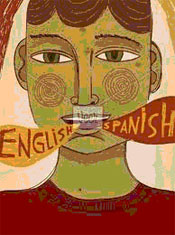 |
|---|
Things can get easily and embarrassingly mixed up. Be sure to use words like pero (means "but") carefully. If you mean dog, it's spelled perro and pronounced perrrrro with a heavy roll on the r's, otherwise if you kiss your pero goodbye in the morning it could have a wholly different meaning.
The words for blooper in (Costa Rican) Spanish are "la metida de pata" (see What's-in-a-Word section below for translation). Attempts at verbatim translations are always dangerous. Bad translations that we would call bloopers are the particular but not exclusive province of online and other automatic translators.
Here's what a machine translator did to a cabbage-based vegetable recipe:
"First, heat up your pants really hot, then add oil. Put the cabbages in salt water. Then sit in the sink until the morning. Next, chop all the vegetarians into little pieces. Next, add a little Buddha and mix it all up. When you are finished cooking, find a suitable bowel and eat it with chopsticks." (I bet it was delicious).
A man requesting three shots of guaro (liquor made from sugar cane) orders: "Tres mocos, por favor" (three snots please)!" He of course meant "mocas". A lady asking for a food product without preservatives tries to improvise by saying "...sin preservativos". What she was really saying was "without condoms"; she should have said "...sin aditivos".
Check out more language translation bloopers here: Tricky Translations.
All of this reminds me of the conversations we used to have when I worked in Brussels. In that office we had Americans, French, Belgians, Dutch, English, Scots, Germans and an Italian or two. Our lunch conversation often turned to bloopers (usually French) but sometimes we raised our sights to higher intellectual levels. After considerable thought we came up with a definition of an international businessman:
"An International Businessman is someone with the driving manners of a Belgian, the humility of a Frenchman, the internationalism of an Englishman, the efficiency of an Italian, the generosity of a Dutchman, the humor of a German, the wit of a Scandinavian and the linguistic ability of an American".
Nuff said.
Triathlon Mission Accomplished
("Sorry, You'll Never Walk Again" - "Wanna Bet?")
Each year, the BMW corporation and others sponsor six athletic events, triathlons, in Costa Rica. The last event each year traditionally is held in Quepos and on December 2 just passed the sixth and last triathlon for 2012 was held here with 510 participants competing.
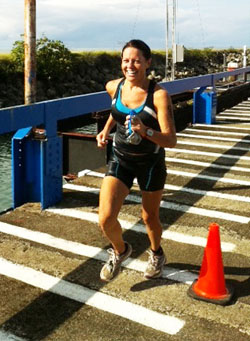 |
|---|
Dina Doing Her Thing |
For the couch potatoes like me, recall that a triathlon consists of three parts (funny how the greek works for that), in this case, for the standard competitor it was: 1) swimming (750 meters/820 yards), 2) bicycling (23 kilometers/14+ miles) and 3) running (5 kilometers/3.1 miles). There are several levels of competition depending on age and skill level.
What makes this year's triathlon a more interesting story than just the competition itself is that a local lady was competing who came to the event with an unusual history. Her name is Dina Moran and, when she's not swimming, bicycling or running (very few days go by when she's not doing one of those) she's the owner and operator of a health food juice bar in Manuel Antonio called Jungle Juice.
Dina is a product of a "mixed" marriage, that's to say her mother is a gringa (U.S.) and her father was a Tico. She holds both U.S. and Costa Rican passports and has lived here for most of her life. Her English and Spanish are interchangeable at will (I'm jealous).
OK, so no big woop so far, eh?
Well how about this. In early 2010 Dina found herself in a hospital in critical condition as a result of a serious illness and, she readily admits, some poor lifestyle decisions. Her condition was so bad the doctors told her that even if she recovered it was highly unlikely she would ever walk again, at least unaided. Well that's like telling Dina there's no fruit in the jungle. She underwent physical rehabilitation and changed her lifestyle completely which meant she gave up unhealthy liquids and foods and began to exercise every day.
In mid-2010 Dina bought her first bicycle and fell in love with the feeling of tooling around and about Quepos (she lives near Inmaculada and routinely bikes into Quepos or across Manuel Antonio hill). Then in 2011 she entered her first Quepos triathlon and posted a time of 2:08 (that's two hours and eight minutes for the people from La Loma). This year, her second triathlon, she bettered her time by 15 minutes. registering 1:53 for the event. That gave her second place in her age division.
With all the bad stuff going on in the world today, ranging from starvation to wars and atrocities, both international and domestic, it surely is good to hear a positive and inspirational story like Dina's.
Felicidades Dina, amiga.
¡Pura Vida!
Aguirre Explained
(How Our Canton Got Its Name)
For governance purposes, Costa Rica is divided into seven provinces and within each province further divided into cantons, also called municipalidades. Quepos and Manuel Antonio are located in the Province of Puntarenas and the Cantón of Aguirre (pronounced ah-gear-ray). Aguirre is one of ten cantons in Puntarenas province. The canton is further divided into three subdivisions or "distritos" but we'll save that detail for another time.
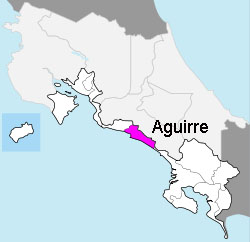 |
|---|
Aguirre Canton Shown in Pink. The White Background is the Province of Puntarenas (How's That Shape for Gerrymandering) |
The Aguirre canton main office, the equivalent of a town or city hall and affectionately know here as the "Muni", is located about three blocks from where GG lives and a block east of the bus station in Quepos.
The canton, like the province, runs along the pacific coast (see map) bounded by the cantons of Osa in the south and Parrita in the north and by the province of San José to the east. In distance it runs about 50 kilometers along the coast and about 8-12 kilometers inland. The total land area is about 544 square kilometers (213 square miles) and has a population of about 25,000 (not counting an additional 25,000 or so visitors and tourists wandering about the area at any given time)..
The canton is named after Rolando Aguirre Lobo, a hero of the 1948 war that resulted in the founding of the modern republic in 1949 when the army was disbanded by constitutional mandate. Señor Aguirre is referred to in the literature as Mártir de la Legión Caribe or Martyr of the Caribbean Legion because of his actions that led to his own death in the civil war that year.
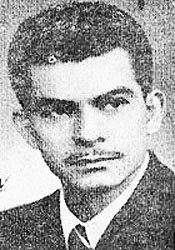 |
|---|
Rolando Aguirre Lobo (Quite a Wolf, eh?) |
Aguirre Lobo (lobo means wolf in Spanish) was born in Heredia in 1918. He went to elementary school in Heredia and high school in Cartago. After graduation, he went to work as a typesetter for the free press in Colombia and Panama. After a few short years he returned to his homeland and settled in Quepos in 1938, working for la Compañía Bananera de Costa Rica (the Costa Rica Banana Company, also known as the United Fruit Company), whose plantations on the Pacific coast of Costa Rica had been prospering for almost a decade. More on Costa Rican banana history here: Choo Choo Chiquita.
Back when there still was an army in Costa Rica, the Legión Caribe was a nationalist military unit charged with the taking of the city of Limón on the caribbean coast in the 1948 civil war. The Legión eventually succeeded in taking Limón but Aguirre, just 30 years old, lost his life in the battle. Aguirre was hunkered down in a building near Limón when a withering fusillade of rifle fire cut the door to the building in which he was housed in half. A second volley hit the young patriot and he became history. Aguirre was the first man of the Legión to perish in the struggle.
Remember.that in the thirties and forties, Quepos was not easily accessible. There was no direct road to Quepos from San José; you either went first to San Isidro, some 50 miles southeast of Quepos by way of what is now the Interamericana and then by horse to Quepos or you took a boat from Puntarenas to Quepos. There were no gravel lined roads, let alone paved ones and no municipal airport like today; that was stuff of futuristic dreams at that time. A trip from San José usually took at least two days. Most of the bananas were shipped by boat and Quepos was a busy, but remote port.
In the crucial decade of 1938 to 1948 young Aguirre was in his twenties when he and others became passionately active about ensuring the country's survival and progress by establishing a republic and, for Aguirre, this also meant improving the situation of his adopted hometown, Quepos. He helped in getting the area first classified as a district and then later the town was promoted to a city (canton/municipalidad). After his death in 1948 and the formation of the Republic, it was only natural and fair that the new canton formed here be called Aguirre.
At least with Señor Rolando Aguirre Lobo we don't have to wonder or ask the question "Who is Rolando Aguirre?" like we did last month with Who is Manuel Antonio? The Costa Rican history of Señor Aguirre is certain and well documented.
Solo Bueno!
What's-in-a-Word
La Metida de Pata
In the "Hablo Muy Good" article above, reference was made to a blooper in Spanish being called la metida de pata. A literal (machine) translation of this term would be "nozy paw", proving once more that literal translations can be dangerous. A kinder, gentler translation would be to think of it as putting one's foot in one's mouth. GG has experience in this area.
Maguire
A friend of mine, of hibernian extraction, made an interesting observation about the name Aguirre. There is some evidence that there was considerable migration from the Iberian peninsula to Ireland hundreds of years ago. Could an Aguirre from Spain have ended up in Ireland and eventually became known as Maguire?
Hell, why not, men from northern Europe, often referred to as norsemen, eventually ended up populating the west coast of France and became known as "Normands". Some of those dudes migrated to Quebec, then to New England and eventually to Costa Rica (you know who). Ya can't keep a good man tied down to one place or culture.
ROMEO Corner
(Retired Old Men Eating Out)
Sunspot Grill at Hotel Makanda - Manuel Antonio
Location: From the main Manuel Antonio road take the side road across from Cafe Milagro and in
front of Casa Blanca, past the Mariposa Hotel down about one kilometer on the right.
Hours: Lunch 12:00 a.m. to 6:00 p.m.; Dinner 6:00 p.m. to 10:00 p.m.;
Reservations suggested
for dinner.
Parking: Ample at the hotel.
Contact: Tel.: 2777-0442; Fax: 2777-1032; Email: info@makanda.com;
Website: http://www.makanda.com/en/sunspot-bar-grill/restaurante-sunspot.html
Reviewing ROMEOS: Brian M., Bob N.
To Review Our Rating System and Procedure, go here: R.O.M.E.O. Rating System
The Hotel Makanda is one of the premium hotels in Manuel Antonio located along the road that runs from the Mariposa Hotel all the way down to the Arenas del Mar Hotel at the Playita. If you don't have a car, it's strongly suggested you take a taxi to the hotel as the walk can be rather challenging. There used to be a regular public bus that ran this road all the way down to the Playita beach and would have delivered you to the Makanda but we understand the scheduled has been greatly reduced and only runs early morning and late afternoon, primarily catering to the employers and other workers that keep the hotels along that road operating.
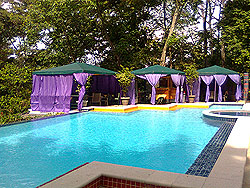 |
|---|
Poolside Terrace at the Sunspot |
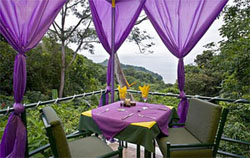 |
View From the Sunspot Grill |
The dining area at the Sunspot is at poolside with a splendorific view of the Pacific Ocean, the jungle leading down to the sea and the edge of Vizanz beach near Punta Quepos. The hotel's ongoing policy is to allow restaurant guests the use of the pool so lunch can be preceded or followed by a dip in the extremely clean, infinity edge pool (we didn't take advantage of this policy on this visit).
The dining area is rather intimate with tables for only about 20. On this particular visit the two ROMEOS were the only diners for lunch. The tables are colorfully decorated with a combination of purple and lemon yellow drapes, table cloths and napkins, creating a very warm atmosphere. There was a small glass vial containing a flower blossom and a variegated leaf from a tropical plant added further decoration. Cloth napkins, silverware and the absence of plastic in any form contributed to the comfort/elegance factor.
The menu was fairly extensive for a lunch menu with an assortment of appetizers, cold and hot sandwiches, burgers, pasta and pizza. The two ROMEOS started with a small plate of a spicy hummus with pita bread wedges - very tasty. After that we both chose the Cuban sandwich which was constructed on an open face crisp roll with an ample layer of pulled pork, the requisite dill pickle slices and a nice red cabbage slaw to top it all off. Delicious. The portion was large enough that both ROMEOS took half their sandwich home in a monkey box (that's the Costa Rican equivalent of a doggie bag).
 |
|---|
$$$$ |
Value Index = 113 |
This ROMEO thought the service was a bit slow, particularly since we were the only ones in the restaurant and the meal was uncomplicated but we passed it off as the kitchen trying to get organized for their first service of the day. The waiter was very polite. friendly and helpful.
We give the restaurant an overall rating of four and a half sloths for atmosphere (5), food quality (4) and service (4).
The meal with the hummus appetizer, two sandwiches and one soft drink came in almost exactly at 20,000 colones or $40 for two. That puts the Sunspot in the top 20% of expense ratings for restaurants in this area and the Value Index at 4/4x100 = 100 or in the middle of the range for all restaurants in this area..
For a good meal in a beautiful setting, the Sunspot Grill at the Hotel Makanda would be an excellent choice for anyone.
Lotus Garden - Puerto Viejo
Location: One kilometer south of Pureto Viejo center on the coast road on the right.
Hours: Breakfast, Lunch, Dinner (It is a hotel after all)
Parking: On the main road (little traffic in this part of the world)
Contact: Tel.: 506-2750-0232; Fax: N/A; Email: lotusgardencr@hotmail.com;
Website: www.lotusgardencr.com
Reviewing ROMEOS: John S., Bob N.
To Review Our Rating System and Procedure, go here: R.O.M.E.O. Rating System
Every now and then one can still find a diamond turning up in the myriad of restaurants available to mankind even when one is not looking for gems (sorry, sometimes I can't resist the hyperbole).
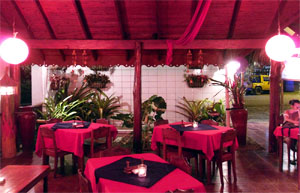 |
|---|
Dining Room at The Lotus Garden |
Such it was one day during a visit to Puerto Viejo, that camp, bohemian little fishing village about 40 miles south of Limón.on the Caribbean coast of Costa Rica. Driving down the coastal road near Playa Cocles I casually spied a sign announcing "The Lotus Garden, Asian Fine Dining and Suites". I made a mental note of the location and returned that evening with a friend for dinner; it turned into a ROMEO review.
The dining room was warmly decorated and gently lit and contained a conversation pit with a sofa as well as a small library to the sides of the room. The effect is to make you feel like you're dining in someone's private dining room. The tables had small vases with fresh flowers, double table cloths (like the picture), candles and there was some padding on the chairs (GG makes a big deal of this because of his back's aversion to standard Tico hard chairs).
As billed, the menu offered a selection of Asian dishes from Chinese to Japanese to Indonesian. The offerings included sashimi from tuna, salmon, marlin and snapper; an assortment of sushi rolls that included shitake mushrooms and freshly pickled ginger and main courses including Chinese sweet and sour pork, Kapanrdr dushis and sashimis, Indonesian satays and Thai curries. GG chose a chicken satay that was served with a mold of small-grain herbed rice and an artfully mounded salad. My friend chose a Thai yellow curry of chicken that had the same accompaniments as my satay. Both plates had a small blossom of different flowers (Bougainvillea, Ixora) as decoration. The kitchen spiced our dishes to different heat levels as my dining partner likes high spice and I wanted only a hint of heat in the peanut sauce. Both ROMEOS pronounced the chicken tender and flavorful. |
 |
|---|---|
$$$1/2 |
|
Value Index = 143
|
Our waitress suggested a certain cheesecake for dessert and, after sampling the good taste of the main course, we succumbed. We shared a large piece of a cheesecake that contained coconut in the filling, a half inch slather of chocolate mouse on top and which was drizzled with local semisweet chocolate sauce. Yummers.
We were serviced during our meal by a Swiss-German lady name Petra who was very pleasant and helpful. She warmed us up initially by offering us a small complimentary plate sampler of eight types of sushi roll. She even gave us a tour after dinner of the suites that make up the hotel (first class amigos).
We give The Lotus Garden five sloths for ambiance, food quality and service.
When we looked at the menu before ordering we were both of the opinion that the price level was quite moderate. So it was; our total bill for the two main courses, desert and soft drinks came to $34. That was for two or $17 per person. That puts it in the middle of our rating system and we give The Lotus Garden 3 1/2 $ for expense rating.
The combination of five sloths and three and a half $ yields a Value Index of 5/3.5x100=143 and puts The Lotus Garden in the tio 10% of restaurants reviewed so far for value. If you're in that region, you should definitely schedule a meal at The Lotus Garden.
don Beto de Quepos, El Gringo Dorado Pura Vida! |
Be pithy but kind. I'm sensitive. |
|---|

